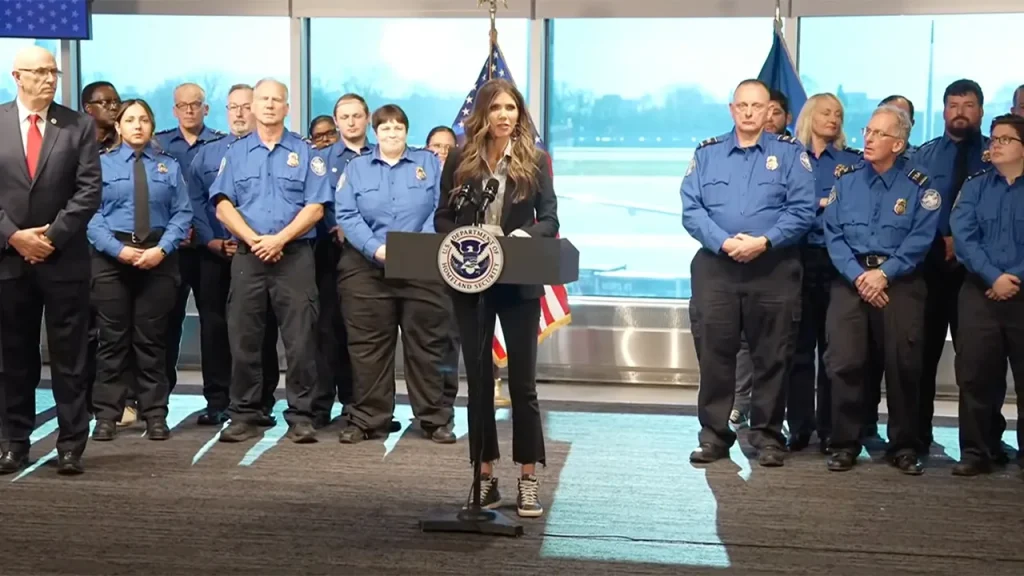DHS Secretary Announces Major TSA Upgrades and Rewards Dedicated Workers
In a move highlighting the Trump administration’s commitment to both national security and federal employees, Department of Homeland Security Secretary Kristi Noem recently announced a significant $1 billion nationwide upgrade to Transportation Security Administration equipment. Speaking at Minneapolis–Saint Paul International Airport, Noem unveiled this major investment alongside $10,000 bonus payments for select TSA employees who demonstrated exceptional dedication during the recent 43-day government shutdown. The announcement represents one of the most substantial investments in transportation security technology in over a decade and signals a renewed focus on modernizing America’s airport security infrastructure.
Secretary Noem’s announcement came with heartfelt praise for TSA workers who maintained operations during the challenging government shutdown that concluded earlier this month. “What we saw during that time period was remarkable,” Noem emphasized, highlighting how these employees continued to prioritize public safety despite personal financial uncertainty. She noted that many TSA agents not only showed up for their regular shifts but often took on additional responsibilities to ensure security standards remained high. The $10,000 bonuses were specifically targeted at exemplary employees standing behind her during the announcement, whom she described as setting an example for all department personnel. This recognition reflects the administration’s stated goal of rewarding federal workers who demonstrate exceptional commitment to public service even under difficult circumstances.
The $1 billion modernization initiative represents a comprehensive overhaul of airport security equipment nationwide, focusing on new scanning equipment, X-ray technology, and Advanced Imaging Technology. Noem emphasized that this investment comes after a significant technological gap, noting it had been “over a decade, maybe 15 years, since the department has put this kind of resources into new technologies.” The upgrades aim to enhance the ability of TSA workers to perform their critical security functions with greater accuracy and efficiency while strengthening overall airport safety protocols. This substantial investment signals a prioritization of transportation security infrastructure that had arguably been neglected through multiple previous administrations.
The TSA announcement follows similar recognition for other transportation workers who maintained essential services during the shutdown. Just days earlier, Secretary of Transportation Sean Duffy and Federal Aviation Administration Administrator Bryan Bedford announced that 776 air traffic controllers and technicians would also receive $10,000 bonus checks for their “patriotic work” during the same period. “These patriotic men and women never missed a beat and kept the flying public safe throughout the shutdown,” Duffy stated, adding pointedly, “Democrats may not care about their financial well-being, but President Trump does.” These parallel announcements highlight a coordinated approach across departments to recognize federal workers in critical security and safety roles.
The timing and nature of these announcements have political dimensions that cannot be overlooked in the current climate. Coming shortly after a contentious government shutdown and amid ongoing debates about federal spending priorities, the billion-dollar investment and bonus payments represent a tangible demonstration of the administration’s priorities. By framing federal workers as “patriotic” and emphasizing their dedication to public safety, the administration appears to be countering narratives about its relationship with the federal workforce. The significant technology investment also provides a concrete example of infrastructure spending that focuses specifically on national security concerns, an area that traditionally garners bipartisan support despite differences on overall government spending.
Looking forward, the implementation of this massive technology upgrade will unfold “over the next many months,” according to Noem. The practical impact for travelers will likely include more efficient and effective security screening processes, potentially reducing wait times while maintaining or enhancing security standards. For TSA employees, the new equipment promises to provide better tools to perform their increasingly complex jobs in a constantly evolving security landscape. Beyond the immediate operational improvements, this investment signals a recommitment to transportation security as a critical component of national infrastructure and public safety. As these changes roll out across America’s airports, they will represent one of the most visible demonstrations of the administration’s approach to balancing security needs with recognition of the human elements that make that security possible.


